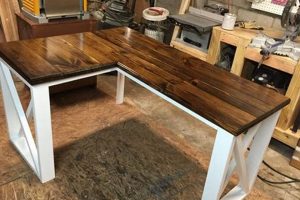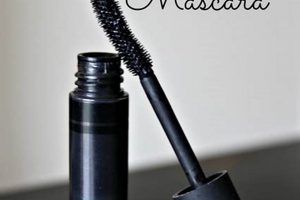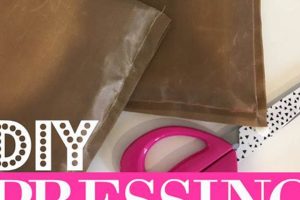At-home eyebrow perming involves the process of chemically altering the structure of eyebrow hairs to create a more lifted, defined, and styled appearance. This procedure typically employs a series of solutions designed to soften the hair, allowing it to be reshaped, and then set into a new position. An example is using specialized kits containing these solutions and application tools to achieve a salon-like effect in a non-professional setting.
The increasing popularity of this technique stems from its potential to enhance facial aesthetics, reduce daily grooming time, and offer a cost-effective alternative to professional salon treatments. The desire for fuller, more sculpted eyebrows, influenced by beauty trends and social media, has driven its adoption. Historically, similar techniques have been employed in hair styling, adapting the principles of chemical reformation for eyebrows.
The following sections will detail necessary precautions, required materials, step-by-step instructions, potential risks, and aftercare recommendations for those considering this cosmetic application. Careful adherence to guidelines is crucial for achieving desired results and minimizing adverse effects.
Essential Considerations for At-Home Eyebrow Perming
Achieving optimal results and minimizing potential complications during at-home eyebrow perming requires meticulous preparation and execution. The following guidelines are designed to enhance the safety and efficacy of the procedure.
Tip 1: Perform a Patch Test: Prior to full application, conduct a sensitivity test by applying a small amount of each solution to a discrete area of skin, such as behind the ear. Monitor for any adverse reactions, including redness, itching, or swelling, for 24-48 hours.
Tip 2: Adhere to Processing Times: Strictly adhere to the manufacturer’s recommended processing times for each solution. Exceeding these times can result in over-processing, leading to damaged or brittle eyebrow hairs.
Tip 3: Use Proper Application Tools: Employ the applicators provided in the kit or clean, disposable applicators to ensure hygienic application and prevent cross-contamination of solutions.
Tip 4: Isolate the Eyebrow Area: Protect the surrounding skin with a barrier cream or petroleum jelly to prevent irritation from chemical solutions. This also aids in defining the desired eyebrow shape.
Tip 5: Neutralize Thoroughly: Ensure complete neutralization of the perming solution by following the kit’s instructions for the neutralizing agent. Inadequate neutralization can lead to continued chemical activity and potential damage to the hair.
Tip 6: Moisturize Post-Treatment: Following the procedure, apply a hydrating serum or oil specifically formulated for eyebrows to restore moisture and prevent dryness. This helps maintain the health and flexibility of the hairs.
Tip 7: Avoid Water Exposure: Refrain from wetting the eyebrows for at least 24 hours post-treatment to allow the perm to fully set. Water exposure can disrupt the chemical bonds and compromise the results.
Tip 8: Consult a Professional: If any irritation, burning, or unexpected results occur, seek immediate advice from a qualified esthetician or dermatologist. Do not attempt to correct issues without professional guidance.
Diligent adherence to these guidelines maximizes the likelihood of achieving desirable results while mitigating potential risks associated with at-home eyebrow perming. Safety and precision are paramount.
The following sections will explore potential risks and aftercare recommendations in more detail.
1. Solution Formulation
The formulation of solutions utilized in at-home eyebrow perming is a critical determinant of both the efficacy and safety of the procedure. Variations in chemical composition, concentration, and pH levels directly impact the degree of hair restructuring and the potential for adverse reactions.
- Perming Agent Composition
The primary perming agent, typically ammonium thioglycolate or a similar compound, breaks down disulfide bonds within the hair’s keratin structure, allowing it to be reshaped. The concentration of this agent dictates the speed and extent of bond disruption. Higher concentrations, while potentially yielding faster results, significantly increase the risk of hair damage and skin irritation. At-home kits often utilize lower concentrations to mitigate risk, which may necessitate longer processing times.
- Alkalizing Agent Influence
An alkalizing agent, such as ammonia or ethanolamine, is incorporated to raise the pH of the solution, facilitating the penetration of the perming agent into the hair shaft. The choice of alkalizing agent and its concentration influences the rate of reaction and the degree of cuticle swelling. Excessive cuticle swelling can lead to porosity and fragility. Some formulations utilize gentler alkalizing agents to minimize this effect, albeit potentially requiring extended processing.
- Neutralizing Solution Components
The neutralizing solution, typically containing hydrogen peroxide or sodium bromate, reforms the disulfide bonds in their new configuration, effectively setting the brows in the desired shape. The concentration and pH of the neutralizing solution are crucial for halting the perming process and preventing continued chemical activity. Incomplete neutralization can result in residual perming agent remaining in the hair, leading to progressive damage and potential skin irritation.
- Buffering System and pH Regulation
Formulations often incorporate a buffering system to maintain a stable pH throughout the perming process. Precise pH regulation is essential for controlling the rate of reaction and minimizing the risk of skin irritation. Deviations from the optimal pH range can lead to either insufficient perming or excessive chemical exposure, both of which can compromise the desired outcome and increase the likelihood of adverse effects. Some advanced formulations incorporate pH-adjusting agents to ensure consistency and predictability.
The interaction between the perming agent, alkalizing agent, neutralizing solution, and buffering system within these solution formulations dictates the overall effectiveness and safety profile of any at-home eyebrow perming process. A thorough understanding of these components is crucial for informed selection and proper execution, ultimately impacting the success and longevity of the desired aesthetic outcome.
2. Adherence Times
The precise timing of each stage within an at-home eyebrow perming procedure, referred to as adherence times, critically influences the outcome and safety of the process. Deviations from recommended durations can lead to suboptimal results or adverse reactions.
The duration for which the perming solution remains on the eyebrows directly impacts the degree of disulfide bond disruption within the hair shaft. Insufficient time results in incomplete softening, preventing effective reshaping. Conversely, exceeding the recommended time leads to over-processing, causing protein breakdown and potentially resulting in brittle, damaged hairs. Visual cues, such as the degree of hair pliability, should supplement timed application, allowing for adjustments based on individual hair thickness and condition.
The neutralizing solution requires a specific application time to effectively reform disulfide bonds in their new configuration. Insufficient neutralization leaves residual perming chemicals active, leading to continued hair damage and potential skin irritation. Extended neutralization, while less detrimental than under-neutralization, can lead to dryness and cuticle hardening. Precise adherence to the kit’s specified time ensures complete chemical deactivation without compromising hair integrity.
The recommended 24-48 hour observation period following a patch test serves as a critical timeframe for detecting delayed hypersensitivity reactions. Shortening this period may fail to reveal subtle irritations or allergic responses that manifest later, potentially leading to widespread inflammation upon full application. Conversely, unnecessarily extending the observation period offers no additional diagnostic benefit and delays the perming process.
The waiting period before wetting or applying products to the eyebrows post-treatment is crucial for allowing the reformed disulfide bonds to fully stabilize. Premature water exposure or product application can disrupt the setting process, compromising the lift and shape achieved. Adhering to the recommended timeframe, typically 24-48 hours, ensures optimal perm retention and minimizes the risk of reversion.
The careful management of these adherence times is integral to maximizing the efficacy and minimizing the risks associated with at-home eyebrow perming. Each time interval is carefully calibrated to balance the desired degree of chemical alteration with the preservation of hair and skin health.
3. Skin Protection
During at-home eyebrow perming, the implementation of robust skin protection measures is paramount. Chemical solutions used in this process, while designed to alter hair structure, can pose significant risks to the surrounding skin, potentially leading to irritation, chemical burns, or allergic reactions. Adequate protective strategies are therefore integral to ensuring a safe and comfortable experience.
- Barrier Cream Application
The application of a barrier cream, such as petroleum jelly or a specialized protective balm, to the skin surrounding the eyebrows serves as a physical shield against chemical exposure. This barrier minimizes direct contact between the perming solutions and the skin, reducing the risk of irritation and chemical burns. For example, applying a thick layer of petroleum jelly along the eyebrow outline creates a buffer zone, preventing solution seepage and protecting sensitive areas. This practice is particularly crucial for individuals with sensitive skin or a history of allergic reactions.
- Precise Application Techniques
Employing precise application techniques minimizes the accidental spread of chemical solutions onto unintended skin areas. Using fine-tipped applicators or small brushes allows for controlled and targeted application, reducing the likelihood of solution contact with the skin. For instance, rather than liberally applying the perming solution, a small brush can be used to carefully paint the solution onto the eyebrows, avoiding the surrounding skin. This method demands greater attention and patience but significantly enhances skin safety.
- Immediate Spill Management
Promptly addressing any spills or accidental contact of chemical solutions with the skin is essential to mitigate potential damage. Immediate rinsing with copious amounts of cool water helps to dilute and remove the chemical agent, reducing the duration of exposure. For example, if perming solution drips onto the forehead, it should be immediately rinsed with water for several minutes to prevent irritation or burns. Having a damp cloth or sponge readily available facilitates rapid spill management.
- Post-Procedure Soothing Treatments
Following the perming process, applying soothing and hydrating treatments to the skin can help alleviate any residual irritation or dryness. Gentle, fragrance-free moisturizers or aloe vera gel can calm the skin and promote healing. For instance, after rinsing off the neutralizing solution, applying a thin layer of aloe vera gel can provide a cooling and anti-inflammatory effect, reducing redness and discomfort. This step supports skin recovery and prevents post-procedure complications.
These skin protection measures, employed individually or in combination, significantly enhance the safety of at-home eyebrow perming. By creating a physical barrier, practicing precise application, managing spills promptly, and providing post-procedure soothing, the risk of adverse skin reactions can be substantially reduced, leading to a more positive and predictable outcome.
4. Neutralization Efficacy
Neutralization efficacy constitutes a critical control point in the at-home eyebrow perming process. The chemical solutions employed to reshape eyebrow hairs disrupt disulfide bonds within the hair’s keratin structure. Neutralization, through the application of a specific solution, reforms these bonds in their new configuration. Inadequate neutralization leaves residual perming agent active, resulting in progressive hair damage, skin irritation, or unpredictable aesthetic outcomes. Conversely, effective neutralization halts the perming process precisely, stabilizing the desired shape and minimizing potential adverse effects. For instance, insufficient neutralization may manifest as continued over-processing, leading to brittle, easily broken eyebrow hairs weeks after the procedure. Effective neutralization is thus the difference between a successful, long-lasting eyebrow perm and a cosmetically detrimental outcome.
The practical significance of understanding neutralization efficacy extends to product selection and application technique. At-home eyebrow perming kits vary in the composition and concentration of their neutralizing solutions. The kit’s instructions regarding application time and method directly influence the effectiveness of neutralization. A thorough understanding of this process enables individuals to critically evaluate product instructions and adjust their technique to ensure complete neutralization. For example, individuals with thicker eyebrow hairs may require slightly longer neutralization times or more thorough application to ensure complete deactivation of the perming agent. Ignoring this critical step invalidates the entire perming procedure.
In summary, neutralization efficacy is not merely a step in the perming process; it is the pivotal control that determines the long-term health and appearance of th
e eyebrows. Challenges associated with achieving consistent neutralization at home include variations in hair thickness, solution quality, and adherence to instructions. However, recognizing the importance of complete neutralization and carefully managing the application process mitigates these risks. A lack of effective neutralization negates the potential benefits of DIY brow lamination, highlighting the need for vigilance and informed decision-making.
5. Hydration Maintenance
Hydration maintenance is a critical, yet often overlooked, aspect of at-home eyebrow perming. The chemical processes involved in reshaping the hair’s structure can strip it of its natural moisture, leading to dryness, brittleness, and potential damage. Proper hydration strategies are therefore essential to preserving the health and integrity of permed eyebrows.
- Post-Treatment Oil Application
Application of nourishing oils following the perming process aids in replenishing lost moisture and restoring the hair’s natural lipid barrier. Oils such as castor oil, argan oil, or coconut oil can be gently massaged into the eyebrows to provide deep hydration. For example, applying a few drops of argan oil nightly can help prevent dryness and brittleness, maintaining the smoothness and shine of the permed hairs. Consistent oil application minimizes the long-term damage associated with chemical processing.
- Hydrating Serum Utilization
Incorporating a hydrating serum into the post-perming care routine provides a concentrated dose of moisture-attracting ingredients, such as hyaluronic acid or glycerin. These serums work by drawing moisture from the surrounding environment into the hair shaft, effectively hydrating from within. As an example, a serum containing hyaluronic acid can be applied after cleansing the eyebrows to enhance their moisture retention, preventing them from becoming dry and fragile. This helps to preserve the elasticity and resilience of the permed hairs.
- Avoiding Harsh Cleansers
The selection of gentle, sulfate-free cleansers is vital for preventing further moisture depletion from permed eyebrows. Harsh cleansers can strip away natural oils, exacerbating dryness and potentially damaging the hair cuticle. Instead, mild, hydrating cleansers should be used to cleanse the eyebrows without compromising their moisture balance. A real-world example is switching from a conventional foaming cleanser to a cream-based cleanser to minimize moisture loss during daily hygiene practices.
- Limiting Heat Exposure
Excessive heat exposure, from styling tools or prolonged sun exposure, can accelerate moisture loss and contribute to dryness and damage in permed eyebrows. Limiting the use of heated styling tools and protecting the eyebrows from direct sunlight can help preserve their hydration levels. As an illustration, wearing a hat or applying a UV-protectant balm can shield the eyebrows from the damaging effects of solar radiation, preventing dryness and color fading. Reducing heat exposure preserves both moisture and the overall health of the permed hairs.
In conclusion, maintaining adequate hydration is an integral component of successful at-home eyebrow perming. By incorporating hydrating oils and serums, avoiding harsh cleansers, and limiting heat exposure, individuals can help preserve the moisture balance of their permed eyebrows, minimizing dryness, brittleness, and potential damage. These hydration strategies contribute to the overall health and longevity of the permed effect, ensuring a more satisfactory aesthetic outcome. A failure to prioritize hydration often results in damaged brows, negating potential cost and time-saving benefits of DIY brow lamination.
6. Shape Definition
Shape definition forms a foundational element within at-home eyebrow perming. The desired eyebrow shape dictates the application of perming solutions and the ultimate aesthetic outcome. Ill-defined shape expectations can lead to haphazard application, resulting in asymmetrical or disproportionate eyebrows. Conversely, a clearly defined shape serves as a blueprint, guiding the perming process and ensuring a balanced, aesthetically pleasing result. For example, individuals aiming for a straighter eyebrow shape will apply solutions differently compared to those seeking a more arched form. Without a predetermined shape, the procedure risks producing an undesirable and difficult-to-correct outcome. Prioritizing shape definition is thus not merely an aesthetic preference but a crucial step for ensuring a successful perming process.
Several factors influence the attainment of defined eyebrow shapes during the perming process. These include the individual’s natural eyebrow hair distribution, the underlying bone structure, and the individual’s skill in manipulating the eyebrow hairs during application. Trimming and shaping the eyebrows prior to solution application provides a foundational structure to work with, aiding in defining the desired shape. Employing tools such as spoolie brushes and stencils can further refine the shape and guide the application process. Real-world applications include using a brow pencil to outline the desired shape before applying perming solutions, providing a visual guide during the procedure. Those lacking experience may benefit from consulting visual resources or seeking guidance from experienced individuals before proceeding.
In summary, shape definition represents an essential prerequisite for effective at-home eyebrow perming. It provides a framework for solution application, minimizes the risk of undesirable outcomes, and maximizes the potential for achieving the desired aesthetic result. While challenges exist in achieving perfect symmetry and definition, understanding the relationship between shape and application is paramount. Proper shaping techniques, pre-application outlining, and seeking external guidance are all strategies that enhance shape definition and contribute to a successful at-home perming experience. Neglecting this component increases the likelihood of asymmetry, unnatural shaping, and potential dissatisfaction with the final result.
7. Aftercare Diligence
Aftercare diligence represents a critical phase following at-home eyebrow perming. The chemical processes involved in reshaping eyebrow hairs render them more vulnerable to damage, requiring specific and consistent maintenance practices to preserve both the aesthetic outcome and the hair’s structural integrity. Neglecting these aftercare protocols can compromise the perming result and potentially lead to adverse conditions affecting hair health.
- Moisture Replenishment Strategies
The perming process often strips the hair of its natural oils, leading to dryness and brittleness. Consistent application of moisturizing agents, such as castor oil or specialized eyebrow serums, is essential for restoring hydration. For example, applying a small amount of castor oil nightly helps to seal in moisture, preventing the hair from becoming brittle and prone to breakage. This replenishes the lipid barrier disrupted during the chemical treatment, preserving hair elasticity.
- Avoidi
ng Abrasive ProductsSubsequent to eyebrow perming, avoidance of harsh cleansers and exfoliants is crucial. These products can further strip the hair of moisture and disrupt the newly formed disulfide bonds, compromising the permed shape. For instance, substituting a gentle, sulfate-free cleanser for a conventional foaming cleanser minimizes the risk of irritation and excessive drying, protecting the integrity of the permed hair structure. This precautionary measure preserves both hair and skin health surrounding the eyebrow area.
- Minimizing Physical Manipulation
Post-perming, excessive rubbing or manipulation of the eyebrows can disrupt the permed shape and cause hair breakage. Limiting contact and avoiding aggressive cleansing techniques is essential for maintaining the desired aesthetic. For example, patting the eyebrows dry with a soft towel rather than rubbing them vigorously minimizes physical stress on the hairs, preventing premature reversion of the permed shape and reducing the risk of damage. This practice promotes longevity of the procedures results.
- Sun Protection Implementation
Exposure to ultraviolet (UV) radiation can damage the permed hair structure and cause color fading. Applying a UV-protectant balm or wearing a hat to shield the eyebrows from direct sunlight is recommended. For example, applying a small amount of clear, fragrance-free sunscreen to the eyebrows before prolonged sun exposure helps to protect them from UV-induced damage, preserving their color and structural integrity. Sun protection contributes to the overall health and appearance of permed eyebrows.
These facets of aftercare diligence are inextricably linked to the success and longevity of at-home eyebrow perming. Neglecting these protocols can negate the benefits of the procedure, leading to damaged, brittle, or misshapen eyebrows. Proper aftercare is thus not an optional addendum but an integral component of the at-home eyebrow perming process, ensuring both aesthetic satisfaction and the continued health of the treated hairs. The benefits of successful DIY brow lamination can be negated through poor aftercare practices.
Frequently Asked Questions
The following questions address common inquiries regarding the practice of at-home eyebrow perming, aiming to clarify uncertainties and provide essential information.
Question 1: How does at-home eyebrow perming differ from professional salon treatments?
At-home kits typically utilize lower concentrations of active chemical agents compared to professional formulations. This aims to mitigate the risk of adverse reactions but may necessitate longer processing times. Professional treatments often incorporate additional steps, such as specialized shaping and customized product selection, tailored to individual needs.
Question 2: What are the primary risks associated with DIY eyebrow lamination?
Potential risks include skin irritation, chemical burns, allergic reactions, over-processing leading to brittle hairs, and unsatisfactory aesthetic outcomes, such as asymmetry or unnatural shaping. Improper adherence to instructions and inadequate skin protection contribute to heightened risk.
Question 3: What qualifications or training are necessary before attempting at-home eyebrow perming?
While no formal qualifications are legally mandated, a thorough understanding of chemical processes, meticulous adherence to safety protocols, and a steady hand are highly recommended. Individuals with sensitive skin or pre-existing skin conditions should exercise extreme caution or seek professional guidance.
Question 4: How can the likelihood of an allergic reaction be minimized?
Prior to full application, a patch test should be conducted by applying a small amount of each solution to a discrete area of skin. A 24-48 hour observation period is necessary to monitor for any adverse reactions, including redness, itching, or swelling. Discontinue use immediately if any signs of irritation appear.
Question 5: What immediate actions should be taken in the event of chemical contact with the eyes?
In the event of eye contact, immediately flush the affected eye with copious amounts of cool water for at least 15 minutes. Seek immediate medical attention from a qualified healthcare professional.
Question 6: How often can eyebrow perming be safely repeated?
Eyebrow perming should be limited to prevent cumulative damage to the hair and skin. A minimum interval of 8-12 weeks between treatments is recommended. Regular hydration and conditioning treatments should be implemented to maintain hair health and minimize dryness.
The information provided is intended for general guidance and does not constitute professional medical or cosmetic advice. Always consult with a qualified expert for personalized recommendations.
The following section will discuss alternative eyebrow enhancement techniques for those hesitant to pursue at-home perming.
Conclusion
This exploration of at-home eyebrow perming has illuminated essential considerations for those contemplating this cosmetic procedure. Key points addressed include the importance of solution formulation, adherence to processing times, the necessity of rigorous skin protection, the criticality of neutralization efficacy, diligent hydration maintenance, precise shape definition, and consistent aftercare practices. The potential risks and benefits associated with attempting eyebrow perming in a non-professional setting have been thoroughly outlined.
Given the inherent risks and the level of precision required, careful deliberation is warranted before undertaking this procedure. Prioritizing safety, meticulous planning, and realistic expectations are crucial. The informed individual will weigh the potential benefits against the possibility of adverse outcomes, recognizing that professional alternatives may offer a safer and more predictable path to achieving desired aesthetic results. A poorly executed brow lamination can lead to both cosmetic and physical damage.







